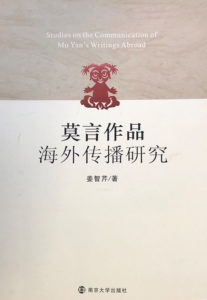
Jiang Zhiqin 姜智芹
Nanjing: Nanjing University Press, 2019
Reviewed by Nishit Kumar (Doctoral Candidate, Jawaharlal Nehru University and HYI Visiting Fellow)
After winning the Nobel Prize for Literature in 2012, Mo Yan’s literary works have garnered immense attention in China and overseas. This has given rise to moyan re ‘莫言热’, which literally means ‘Mo Yan Fever’. This Mo Yan Fever has further triggered dushure ‘读书热’ (reading fever) among readers and subsequently chuangzuore ‘创作热’ (creation fever) among writers. As Jiang Zhiqin’s book shows, this has opened a new channel for Chinese literature to have a global presence.
Jiang’s book is divided into five sections and spread over nineteen chapters. The central argument suggests that Mo Yan provided an excellent case for the successful zouchuqu ‘走出去’ (going out) and zoujinqu ‘走进去’ (going in) of Chinese literature. The first section, an introductory chapter, gives an overview of translations of Mo Yan’s works in Western languages and Eastern languages. Taking in account the translators, publishing houses, and the languages, this chapter maps out the factors responsible for the overseas publication, distribution and reception of Mo Yan’s work in the West. The second section of this book discusses the individual novels of Mo Yan: Red Sorghum, Garlic Ballads, and Big Breasts & Wide Hips. Further, it delves on the impact of foreign research on the domestic Chinese research of Mo Yan and cross-cultural dialogue in Eastern and Western academia. In the Western world, this book mainly focuses on the English-speaking world, France, and Germany, and in the East, it primarily focuses on the interpretation of Mo Yan’s works in China, Japan, Korea, and Vietnam. In section four, this book deciphers the literary tradition of Mo Yan. It looks at how Mo Yan writes in a unique way, an assimilation of both regional and foreign literary traditions to create his own style, calling it the moyan shi 莫言式 (Mo Yan style). In the last section, the author gives a brief discussion about the Nobel Prize win and responses to the prize in China and Western media.
This book is empirically rich and offers a valuable perspective for understanding ‘Mo Yan Fever’ and ‘Mo Yan Style’. Although, the book is empirically rich, it mainly focuses on Western countries, limiting its focus on Eastern countries, particularly China’s neighboring nations, such as India. It also fails to give any perspective on dissemination of Mo Yan’s works in Africa.
